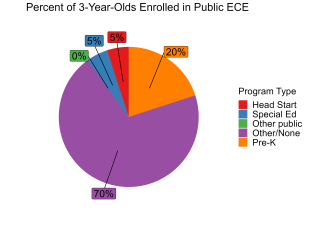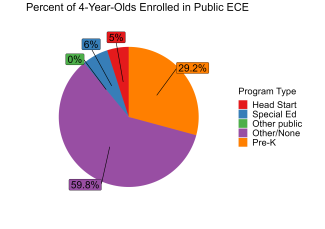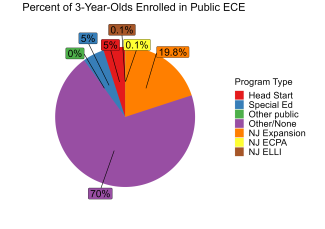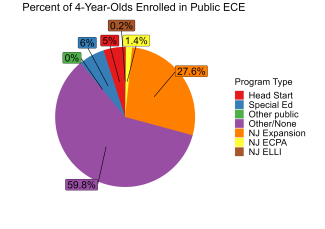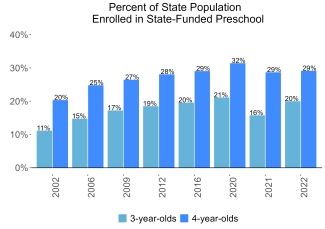
State of Preschool
New Jersey
Access Rankings
Resource Rankings
Total Benchmarks Met

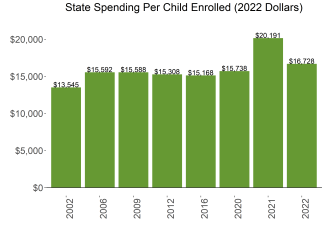
Overview
During the 2021-2022 school year, New Jersey preschool programs enrolled 53,293 children, an increase of 6,398 from the prior year, as preschool in the state began to recover from the impact of the COVID-19 pandemic. State funding totaled $891,476,664, down $55,369,735 (6%), adjusted for inflation since last year. State spending per child equaled $16,728 in 2021-2022, down $3,463 from 2020-2021, adjusted for inflation. New Jersey met 8 of 10 quality standards benchmarks.
What's New
For the 2022-2023 school year, Governor Murphy and the legislature approved a $40 million increase (in nominal dollars) to expand preschool, marking the sixth year in a row of increased funding for state preschool. Most of the increased funding went to support new seats for preschoolers, but some was also earmarked to provide a cost of living increase for all other existing preschool seats. In an effort to expand the program to new areas of the state, school district eligibility levels were reduced from 20% of children eligible for FRPL to 10% of children.
The Governor also announced forthcoming plans to reach universal preschool and in October 2022 released the New Jersey Strategic Plan for Preschool Expansion Phase I: The Foundation. A companion implementation plan is currently being drafted and is anticipated for release in the fall of 2023.
In January 2023, New Jersey was awarded a federal Preschool Development Grant Birth through Five (PDG B–5) renewal grant for $2.3 million. The NJ Department of Labor is the lead on this grant and funds will primarily be used to increase the capacity of the workforce.
Background
New Jersey funds three preschool programs. The largest and most intensive of the programs, formerly known as the Abbott Preschool Program, was originally established under a 1998 New Jersey Supreme Court mandate to serve all 3- and 4-year-olds in 31 of the state’s lowest income school districts. Since 2018, the state has expanded the program to serve 51,310 children in 180 districts during the 2021-2022 school year. Now referred to as the state’s Preschool Expansion Program, the program includes the original 31 Abbott districts as well as districts more recently approved to expand their preschool programs to meet Abbott standards. The NJ Department of Education funds eligible districts to provide a full-day program to all 3- and 4-year-olds who live in those districts and choose to enroll. The original 31 Abbott districts are required to contract with licensed private child care centers or Head Start programs that meet state standards. All other districts are encouraged, but not required, to contract with private child care or Head Start.
The non-Abbott Early Childhood Program Aid (ECPA) program operates in districts where 20% to 40% of children met the criteria for FRPL when the program was established in the late 1990’s. New Jersey’s third program, formerly known as the Early Launch to Learning Initiative (ELLI), was established in 2004 as part of an effort to expand access to high-quality pre-K education to all 4-year-olds in low-income households across the state. There is some overlap between districts in the ECPA and ELLI programs, and some of these districts have recently elected to expand their programs in line with the former Abbott program.
-
Access
Resources
Total state pre-K spending $891,476,664 State Head Start spending $48,481,162 State spending per child enrolled $16,728 All reported spending per child enrolled* $16,728 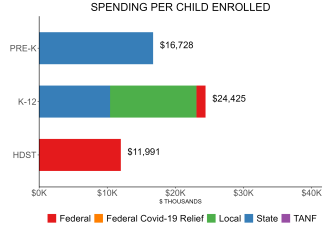
Pre-K programs may receive additional funds from federal or local sources that are not included in this figure. K–12 expenditures include capital spending as well as current operating expenditures. Head Start per-child spending includes funding only for 3- and 4-year-olds.
-
Access
Resources
Total state pre-K spending $876,784,550 Local match required? No State spending per child enrolled $17,088 All reported spending per child enrolled* $17,088 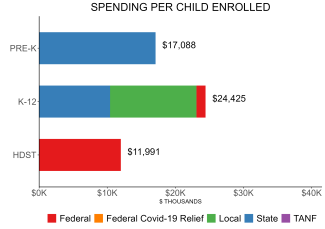
Pre-K programs may receive additional funds from federal or local sources that are not included in this figure. K–12 expenditures include capital spending as well as current operating expenditures. Head Start per-child spending includes funding only for 3- and 4-year-olds.
New Jersey Abbott/Expansion Quality Standards Checklist
| Policy | NJ Abbott/Expansion Requirement | Benchmark | Meets Benchmark? |
|---|---|---|---|
For more information about the benchmarks, see the Executive Summary and the Roadmap to State pages. | 8benchmarks met | ||
| Early Learning & Development Standards Benchmark | Comprehensive, aligned, supported, culturally sensitive | Comprehensive, aligned, supported, culturally sensitive | |
| Curriculum Supports Benchmark | Approval process & supports | Approval process & supports | |
| Teacher Degree Benchmark | BA | BA | |
| Teacher Specialized Training Benchmark | ECE | Specializing in pre-K | |
| Assistant Teacher Degree Benchmark | HSD | CDA or equivalent | |
| Staff Professional Development Benchmark | 100 hours/5 years; PD plans (teachers only); Coaching | For teachers & assistants: At least 15 hours/year; individual PD plans; coaching | |
| Maximum Class Size Benchmark | 15 (3- & 4-year-olds) | 20 or lower | |
| Staff to Child Ratio Benchmark | 2:15 (3- & 4-year-olds) | 1:10 or better | |
| Screening & Referral Benchmark | Vision, hearing, health & more | Vision, hearing & health screenings; & referral | |
| Continuous Quality Improvement System Benchmark | Structured classroom observations; Data used for program improvement | Structured classroom observations; data used for program improvement | |
-
Access
Resources
Total state pre-K spending $13,758,214 Local match required? No State spending per child enrolled $8,253 All reported spending per child enrolled* $8,253 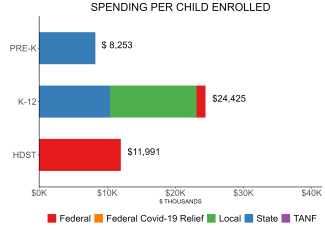
Pre-K programs may receive additional funds from federal or local sources that are not included in this figure. K–12 expenditures include capital spending as well as current operating expenditures. Head Start per-child spending includes funding only for 3- and 4-year-olds.
New Jersey Former Non-Abbott Early Childhood Program Aid (ECPA) Quality Standards Checklist
| Policy | NJ ECPA Requirement | Benchmark | Meets Benchmark? |
|---|---|---|---|
For more information about the benchmarks, see the Executive Summary and the Roadmap to State pages. | 8benchmarks met | ||
| Early Learning & Development Standards Benchmark | Comprehensive, aligned, supported, culturally sensitive | Comprehensive, aligned, supported, culturally sensitive | |
| Curriculum Supports Benchmark | Approval process & supports | Approval process & supports | |
| Teacher Degree Benchmark | BA | BA | |
| Teacher Specialized Training Benchmark | ECE | Specializing in pre-K | |
| Assistant Teacher Degree Benchmark | HSD | CDA or equivalent | |
| Staff Professional Development Benchmark | 100 hours/5 years; PD plans (teachers only); Coaching | For teachers & assistants: At least 15 hours/year; individual PD plans; coaching | |
| Maximum Class Size Benchmark | 18 (3- & 4-year-olds) | 20 or lower | |
| Staff to Child Ratio Benchmark | 1:9 (3- & 4-year-olds) | 1:10 or better | |
| Screening & Referral Benchmark | Vision, hearing, health & more | Vision, hearing & health screenings; & referral | |
| Continuous Quality Improvement System Benchmark | Structured classroom observations; Data used for program improvement | Structured classroom observations; data used for program improvement | |
-
Access
Resources
Total state pre-K spending $933,900 Local match required? No State spending per child enrolled $2,955 All reported spending per child enrolled* $2,955 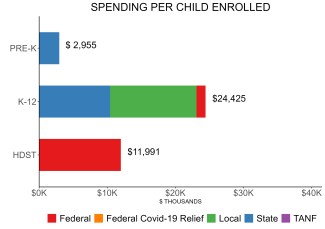
Pre-K programs may receive additional funds from federal or local sources that are not included in this figure. K–12 expenditures include capital spending as well as current operating expenditures. Head Start per-child spending includes funding only for 3- and 4-year-olds.
New Jersey Former Early Launch to Learning Initiative (ELLI) Quality Standards Checklist
| Policy | Requirement | Benchmark | Meets Benchmark? |
|---|---|---|---|
For more information about the benchmarks, see the Executive Summary and the Roadmap to State pages. | 8benchmarks met | ||
| Early Learning & Development Standards Benchmark | NA - Program level only | Comprehensive, aligned, supported, culturally sensitive | |
| Curriculum Supports Benchmark | NA - Program level only | Approval process & supports | |
| Teacher Degree Benchmark | NA - Program level only | BA | |
| Teacher Specialized Training Benchmark | NA - Program level only | Specializing in pre-K | |
| Assistant Teacher Degree Benchmark | NA - Program level only | CDA or equivalent | |
| Staff Professional Development Benchmark | NA - Program level only | For teachers & assistants: At least 15 hours/year; individual PD plans; coaching | |
| Maximum Class Size Benchmark | NA - Program level only | 20 or lower | |
| Staff to Child Ratio Benchmark | NA - Program level only | 1:10 or better | |
| Screening & Referral Benchmark | NA - Program level only | Vision, hearing & health screenings; & referral | |
| Continuous Quality Improvement System Benchmark | NA - Program level only | Structured classroom observations; data used for program improvement | |
